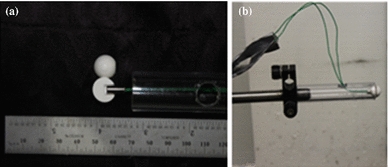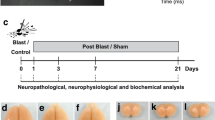Abstract
Blast-induced neurotrauma (BINT) is a common injury associated with the present military conflicts. Exposure to the shock-wave produced from exploding ordnances leads to significant neurological deficits throughout the brain and spinal cord. Prevention and treatment of this injury requires an appropriate understanding of the mechanisms governing the neurological response. Here, we present a novel ex-vivo BINT model where an isolated section of guinea pig spinal cord white matter is exposed to the shock-wave produced from a small scale explosive event. Additionally, we define the relationship between shock-wave impact, tissue deformation and resulting anatomical and functional deficits associated with BINT. Our findings suggest an inverse relationship between the magnitude of the shock-wave overpressure and the degree of functional deficits using a double sucrose gap recording chamber. Similar correlations are drawn between overpressure and degree of anatomical damage of neuronal processes using a dye-exclusion assay. The following approach is expected to significantly contribute to the detection, mitigation and eventual treatment of BINT.






Similar content being viewed by others
References
Argyros, G. J., Management of primary blast injury. Toxicology 121:105–115, 1997.
Cernak, I., Wang, Z., Jiang, J., et al., Ultrastructural and functional characteristics of blast injury-induced neurotrauma. J Trauma 50:695–706, 2001.
Chavko, M., Koller, W. A., Prusaczyk, W. K., et al., Measurement of blast wave by a miniature fiber optic pressure transducer in the rat brain. J Neurosci Methods 159:277–281, 2007.
Jones, E., Fear, N. T., and Wessely, S., Shell shock and mild traumatic brain injury: a historical review. Am J Psychiatry 164:1641–1645, 2007.
Kaur, C., Singh, J., Lim, M. K., et al., The response of neurons and microglia to blast injury in the rat brain. Neuropathol Appl Neurobiol 21:369–377, 1995.
Mayorga, M. A., The pathology of primary blast overpressure injury. Toxicology 121:17–28, 1997.
Murphy, E. J., and Horrocks, L. A., A Model for Compression Trauma—Pressure-Induced Injury in Cell-Cultures. Journal of Neurotrauma 10:431–444, 1993.
Shepard, S. R., Ghajar, J. B., Giannuzzi, R., et al., Fluid percussion barotrauma chamber: a new in vitro model for traumatic brain injury. J Surg Res 51:417–424, 1991.
Shi, R., The dynamics of axolemmal disruption in guinea pig spinal cord following compression. J Neurocytol 33:203–11, 2004.
Shi, R., Asano, T., Vining, N. C., et al., Control of membrane sealing in injured mammalian spinal cord axons. J Neurophysiol 84:1763–1769, 2000.
Shi, R., and Blight, A. R., Compression injury of mammalian spinal cord in vitro and the dynamics of action potential conduction failure. J Neurophysiol 76:1572–1580, 1996.
Ackowledgement
The authors thank Michel Schweinsberg for the graphic illustrations and Mike Koppes for providing the explosives used throughout the study. The funding for this study was partially provided by the State of Indiana and the Indiana Spinal Cord and Brain Injury Research Fund.
Author information
Authors and Affiliations
Corresponding author
Rights and permissions
About this article
Cite this article
Connell, S., Ouyang, H. & Shi, R. Modeling Blast Induced Neurotrauma in Isolated Spinal Cord White Matter. J Med Syst 35, 765–770 (2011). https://doi.org/10.1007/s10916-010-9464-5
Received:
Accepted:
Published:
Issue Date:
DOI: https://doi.org/10.1007/s10916-010-9464-5




